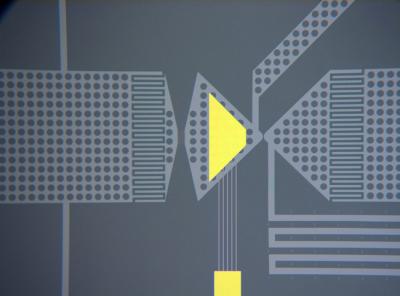Home > Press > New instrument keeps an 'eye' on nanoparticles
 |
| This is an optical microscope image of the microfluidic channel (light pattern) and sensing electrode (gold) of the analyzer. Nanoparticles are suspended in a fluid flow through the channel, and are detected individually as they pass through the sensing volume.
Credit: J.L. Fraikin and A.N. Cleland, UCSB |
Abstract:
Precision measurement in the world of nanoparticles has now become a possibility, thanks to scientists at UC Santa Barbara.
The UCSB research team has developed a new instrument capable of detecting individual nanoparticles with diameters as small as a few tens of nanometers. The study will be published on line this week by Nature Nanotechnology, and appear in the April print issue of the journal.
New instrument keeps an 'eye' on nanoparticles
Santa Barbara | Posted on March 6th, 2011"This device opens up a wide range of potential applications in nanoparticle analysis," said Jean-Luc Fraikin, the lead author on the study. "Applications in water analysis, pharmaceutical development, and other biomedical areas are likely to be developed using this new technology." The instrument was developed in the lab of Andrew Cleland, professor of physics at UCSB, in collaboration with the group of Erkki Ruoslahti, Distinguished Professor, Sanford-Burnham Medical Research Institute at UCSB.
Fraikin is presently a postdoctoral associate in the Marth Lab at the Sanford-Burnham Medical Research Institute's Center for Nanomedicine, and in the Soh Lab in the Department of Mechanical Engineering at UC Santa Barbara.
The device detects the tiny particles, suspended in fluid, as they flow one by one through the instrument at rates estimated to be as high as half a million particles per second. Fraikin compares the device to a nanoscale turnstile, which can count -- and measure -- particles as they pass individually through the electronic "eye" of the instrument.
The instrument measures the volume of each nanoparticle, allowing for very rapid and precise size analysis of complex mixtures. Additionally, the researchers showed that the instrument could detect bacterial virus particles, both in saline solution as well as in mouse blood plasma.
In this study, the researchers further discovered a surprisingly high concentration of nanoparticles present in the native blood plasma. These particles exhibited an intriguing size distribution, with particle concentration increasing as the diameter fell to an order of 30 to 40 nanometers, an as-yet unexplained result.
####
For more information, please click here
Contacts:
Gail Gallessich
805-893-7220
Copyright © University of California - Santa Barbara
If you have a comment, please Contact us.Issuers of news releases, not 7th Wave, Inc. or Nanotechnology Now, are solely responsible for the accuracy of the content.
| Related News Press |
News and information
![]() Simulating magnetization in a Heisenberg quantum spin chain April 5th, 2024
Simulating magnetization in a Heisenberg quantum spin chain April 5th, 2024
![]() NRL charters Navy’s quantum inertial navigation path to reduce drift April 5th, 2024
NRL charters Navy’s quantum inertial navigation path to reduce drift April 5th, 2024
![]() Discovery points path to flash-like memory for storing qubits: Rice find could hasten development of nonvolatile quantum memory April 5th, 2024
Discovery points path to flash-like memory for storing qubits: Rice find could hasten development of nonvolatile quantum memory April 5th, 2024
Imaging
![]() Nanoscale CL thermometry with lanthanide-doped heavy-metal oxide in TEM March 8th, 2024
Nanoscale CL thermometry with lanthanide-doped heavy-metal oxide in TEM March 8th, 2024
![]() The USTC realizes In situ electron paramagnetic resonance spectroscopy using single nanodiamond sensors November 3rd, 2023
The USTC realizes In situ electron paramagnetic resonance spectroscopy using single nanodiamond sensors November 3rd, 2023
![]() Observation of left and right at nanoscale with optical force October 6th, 2023
Observation of left and right at nanoscale with optical force October 6th, 2023
Discoveries
![]() Chemical reactions can scramble quantum information as well as black holes April 5th, 2024
Chemical reactions can scramble quantum information as well as black holes April 5th, 2024
![]() New micromaterial releases nanoparticles that selectively destroy cancer cells April 5th, 2024
New micromaterial releases nanoparticles that selectively destroy cancer cells April 5th, 2024
![]() Utilizing palladium for addressing contact issues of buried oxide thin film transistors April 5th, 2024
Utilizing palladium for addressing contact issues of buried oxide thin film transistors April 5th, 2024
Announcements
![]() NRL charters Navy’s quantum inertial navigation path to reduce drift April 5th, 2024
NRL charters Navy’s quantum inertial navigation path to reduce drift April 5th, 2024
![]() Discovery points path to flash-like memory for storing qubits: Rice find could hasten development of nonvolatile quantum memory April 5th, 2024
Discovery points path to flash-like memory for storing qubits: Rice find could hasten development of nonvolatile quantum memory April 5th, 2024
Tools
![]() Ferroelectrically modulate the Fermi level of graphene oxide to enhance SERS response November 3rd, 2023
Ferroelectrically modulate the Fermi level of graphene oxide to enhance SERS response November 3rd, 2023
![]() The USTC realizes In situ electron paramagnetic resonance spectroscopy using single nanodiamond sensors November 3rd, 2023
The USTC realizes In situ electron paramagnetic resonance spectroscopy using single nanodiamond sensors November 3rd, 2023
|
|
||
|
|
||
| The latest news from around the world, FREE | ||
|
|
||
|
|
||
| Premium Products | ||
|
|
||
|
Only the news you want to read!
Learn More |
||
|
|
||
|
Full-service, expert consulting
Learn More |
||
|
|
||








